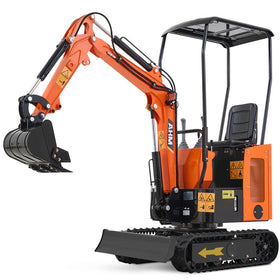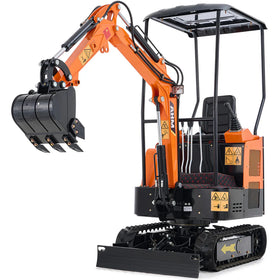Introduction
Need to work in a confined area? Mini excavators excel in tight spaces. These compact machines change the way work is done in tight spaces, from narrow urban lots to small backyard projects. However, it takes special skills to pick out and run the right machine for those small spaces.
This guide gives you:
- Key features for tight-space mini excavators
- Ways to make things run more smoothly in small spaces
- Factors to consider when selecting your machin
By the end of this guide, you'll know how to use mini excavators safely in tight spaces and ensure project success in any confined work area.

1. Why Small Size Is So Important
Size does matter in tight spots. When choosing a mini excavator for tight spaces, these factors should come first:
- Width: If the space is tight, choose types that are less than 40 inches wide.
- Height: Choose lower shapes if you don't have a lot of room above you.
- Length: To get around hurdles, choose shorter machines.

For example, some Kubota mini excavators offer models as narrow as 36 inches, which make them great for garden gates or between buildings. Before making your selection, measure your most restrictive access points. This crucial step ensures the excavator will fit where you need it to work, saving time and preventing potential issues on-site.
2. Zero Tail Swing: Your Ally in Confined Spaces
Zero tail swing design changes the way work is done in tight areas. This innovative feature allows the excavator's counterweight to stay within the width of the tracks during rotation. The benefits include:
- Allows operation close to walls or fences
- Reduces risk of damage to nearby structures
- Improves operator confidence in restricted environments
This function is very useful in cities or other places with a lot of people. With zero tail swing, you can focus on the job at hand without having to worry about how the machine's back is moving all the time. This makes working in tight areas much safer and more productive.
3. Making use of lightweight design
A lighter mini excavator offers several advantages in small spaces:
- Less ground pressure for areas that are easily damaged
- Better transportation between job sites
- Better control on soft ground
Consider the 1 ton mini excavator model for most tight-space applications. Most of the time, these machines are the right mix of strength and flexibility, able to handle most tasks without limiting their mobility. Their small size and light weight make them great for getting through tight areas, but they can still dig and lift heavy things very well.
4. Making the most of maneuverability in limited spaces
Being agile is important in small areas. To improve movement, look for these key features:
- Small turning circle for getting around obstacles
- Rubber wheels for better grip and less damage to the surface
- Expandable tracks let you change the width to fit different spaces
These parts make work a lot easier in small yards and between buildings that are already there. It's very helpful to be able to change the width of the track so that it can fit through small gaps and then grow for stability during operation. Because of this, mini excavators can be used in a lot of different situations where room is limited.
5. Mastering User-Friendly Controls
For tight areas to work well, controls need to be easy to use:
- Easy-to-use joystick buttons
- The operator's seat has a clear view of the road.
- Ergonomic design makes it easy to work with precision.

A lot of modern mini excavators have LCD screens that show machine info in real time. This higher level of awareness is very important in tough, tight spaces where every move matters. Operators can work more accurately and with more confidence in small areas when the controls are easy to use and the information is shown clearly.
6. Adding more features with flexible attachments
The right mini excavator attachments enhance work in tight spaces:
- Small buckets for accurate grading and digging
- Short-reach augers for making holes
- Narrow grapples for moving things
- Small hydraulic tools for breaking up concrete

Machines with quick-coupler technology should be given priority. Swift attachment changes can help you get more done on projects that need to be flexible and take up little room.
7. Making use of hydraulic power in small spaces
Don't be fooled by their small size—modern mini tractors have a lot of power:
- Lifting capacities exceeding 1,500 pounds
- Digging depths over 8 feet
- Robust systems for challenging soil conditions
When comparing models for tight-space work, focus on digging force and lift capacity. These metrics indicate the machine's ability to perform efficiently in confined areas where larger equipment can't access. The combination of compact size and impressive power makes mini excavators ideal for a wide range of applications in restricted spaces.
8. Prioritizing Safety in Confined Work Areas
Safety is paramount when operating in tight spaces. Essential safety features include:
- ROPS (Roll Over Protective Structure) and FOPS (Falling Object Protective Structure)
- Low center of gravity to enhance stability during operation
- Emergency shut-off switches for quick response in critical situations
- Travel alarms to alert nearby workers in low-visibility conditions
- 360-degree visibility to maintain awareness of surroundings
These features ensure operator safety and protect surrounding structures in challenging, confined work environments. Always prioritize safety when selecting and operating a mini excavator in tight spaces.
9. Streamlining Maintenance for Optimal Performance
Regular maintenance keeps your mini excavator ready for tight-space challenges:
- Choose models with accessible service points
- Establish a routine of daily maintenance checks
- Consider machines with onboard diagnostics for quick troubleshooting
Some manufacturers group service points to streamline routine checks and maintenance. This reduces downtime—a critical factor when working on tight schedules in confined spaces.
10. Tricks for Getting Through Very Tight Spaces
Learn these skills to deal with difficult spaces that are limited:
- Plan how you'll do it: Plan your moves to avoid having to move around too much.
- To stay stable, use the boom: Use the boom and arm to help you out in tight spots.
- Use machine movement to: For the best placement, use the excavator's 360-degree turn.
- Do things in chunks: To avoid taking on too much, break up big jobs into smaller ones.
- Use points of reference: Find set points to figure out how far away things are and stay away from them.
These techniques allow efficient and safe work even in the most restricted areas.
Conclusion: Conquering Limited Spaces with the Right Mini Excavator
The right mini excavator for tight spaces can revolutionize challenging projects. When choosing, prioritize:
- Small size with zero tail swing
- Design that is light and easy to move around
- Attachments that can be used for a variety of jobs
- Easy-to-use controls for accurate operation
- Strong safety features
- Easy access for upkeep

Before you buy, you might want to rent a few different types to see how well they work in the tight spaces where you need them. This hands-on experience helps you figure out which features are most important for your confined-area jobs.
To do well in small areas, you need the right mix of size, strength, and flexibility. Pay attention to important details and improve your tight-space operation skills so you can confidently take on even the hardest confined-area projects.
If you have the right mini excavator and know how to use it correctly, you can fit all of your big ideas into any area. Accept confined-space work, and you'll see your project and productivity grow even as your work places get smaller.







